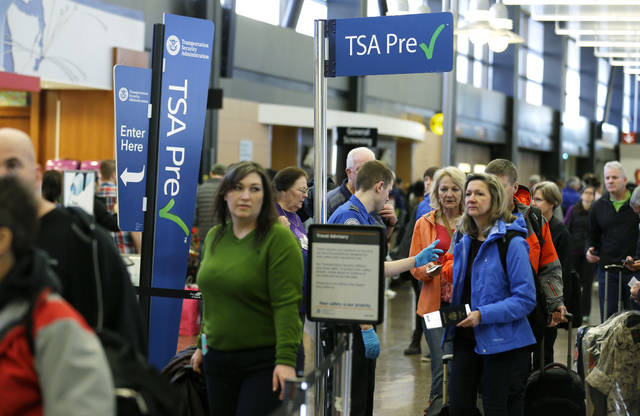Long security lines at airports might move more quickly soon

ASSOCIATED PRESS
Travelers authorized to use the Transportation Security Administration’s PreCheck expedited security line at Seattle-Tacoma International Airport in Seattle in 2017. The TSA has introduced a new kind of machine to screen carry-on bags.
There is a glimmer of hope that the frustrating, slow airport security experience will get a little smoother over the next few years.
In a partnership with American Airlines, the Transportation Security Administration introduced a new kind of machine last month to screen carry-on bags in Terminal 8 at Kennedy International Airport in New York.
The machines, the agency says, improve on the current system, in which most travelers have their carry-on bags screened by X-ray machines that produce only two-dimensional images of their contents. If agents are unsure of what they’re seeing, they pull the bag aside and inspect its contents manually.
The new machines use computed tomography, a technology that produces three-dimensional images so detailed they can even show the mass and densities of items in the bag, including liquids inside their containers. With the new machines, the TSA says, security agents will be better able to analyze what is inside a bag and will be less likely to have to perform searches by hand.
“CT is something that has been looked at to respond to the threats against aviation security since the 1990s,” said Keith Goll, acting deputy assistant administrator for the agency’s office of requirement and capability analysis.
The technology has been used to screen checked baggage since shortly after the terrorist attacks of Sept. 11, 2001. The TSA, formed after the attacks, explored using CT machines to scan carry-on bags as well, but Goll said the technology was not developed or compact enough to be effective, until recently.
Don't miss out on what's happening!
Stay in touch with breaking news, as it happens, conveniently in your email inbox. It's FREE!
“Based on the progression of the technology and the emergence of some of the threat streams we had over the last year, it was time for TSA to take a look at this technology and see if it was ready,” Goll said.
The machines were used first in Phoenix and Boston in June 2017 before arriving at Kennedy.
“As the CT program evolves,” said Michael Bilello, assistant administrator for public affairs at the agency, “there will be an evolution of what passengers can keep in their bags.”
The biggest change right now is that passengers using the CT lanes will be able to leave their laptops in their bags for screening, and as the trials progress, more items may be able to stay in bags.
© 2018 The New York Times Company



